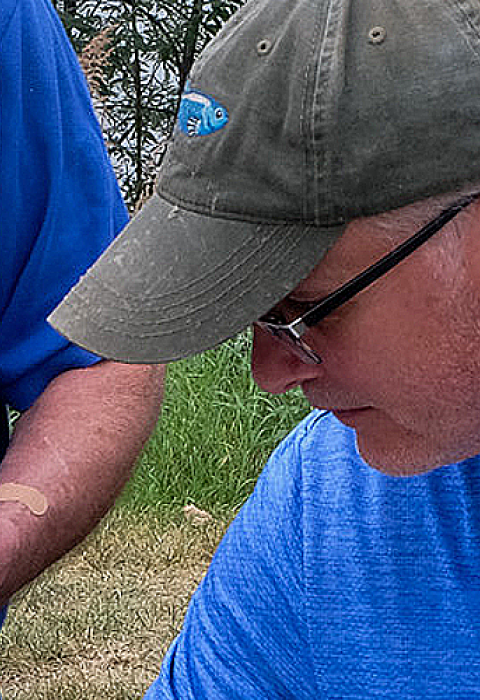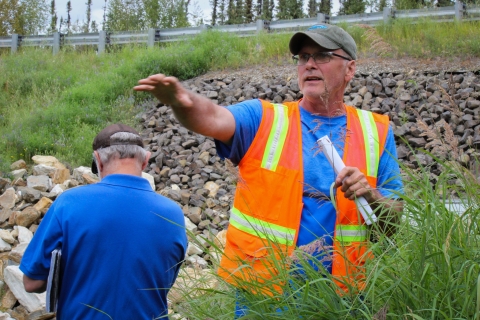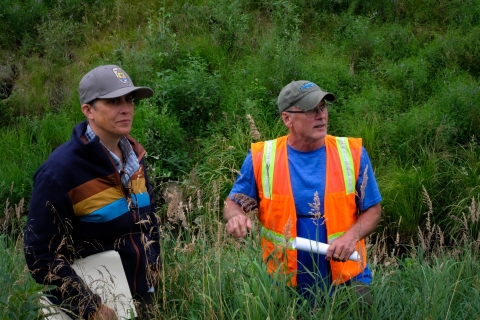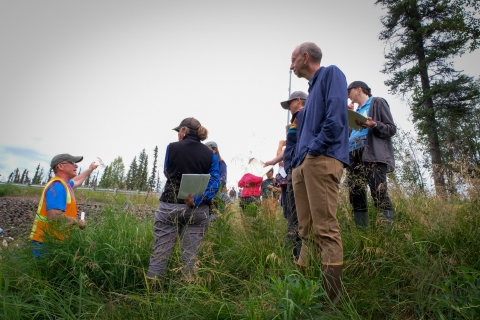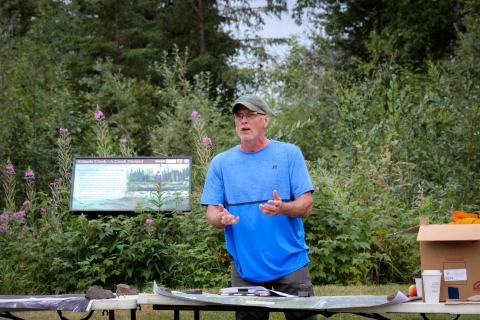Surrounded by caribou herds and the hum of heavy machinery, Mitch Osborne was faced with a life-changing decision.
“The good news is we want you,” the message crackled over his phone one summer day in 1986, reaching Osborne at his seasonal job at the University of Alaska-Fairbanks. Fresh out of the Army and Air Force, the self-proclaimed “hillbilly from Pennsylvania” had been earning a modest start in wildlife work as a farmhand at the school’s Large Animal Research Station. But he yearned for greater opportunities to learn, and was patiently waiting for a big break to go his way.
“The bad news,” continued Dick Wilmont, an Anchorage-based geneticist whom Osborne had spoken with before about his fisheries-focused career ambitions, “is we’d need you out in Emmonak tomorrow.”
Not bad news at all – less than 24 hours later, outfitted in hip boots and a life jacket, Osborne found himself on a bush plane en route to the Yukon Delta. His career in conversation began with an 82-day detail on the refuge, collecting fish tissue samples – often from caught-and-released 60-pound Chinook Salmon – to send back to Wilmont’s lab.
“The weather report that summer was mud and mosquitos,” Osborne recalls. “We stayed out until the very last salmon run.”
That summer in the bush was just the start, and for the next six years Osborne rarely stood still. He balanced fish genetics research with field work – in streams, tundra, snow, and ice throughout the state – while continuing to serve in the Air National Guard’s 168th Wing training air crews in life support.
In 1992, he landed his first permanent position with the U.S. Fish and Wildlife Service as a fish technician, using sonars to enumerate Chinook and Chum Salmon in the Yukon, Kuskokwim, Chandalar, Hulahula, and other rivers throughout Alaska. Later, his responsibilities expanded to helping lead the region’s National Fish Passage and Partners for Fish and Wildlife programs, working in streambank restoration and fish habitat conservation throughout the Arctic.
“The Service allowed me to see the state,” Osborne says. “I don’t take it for granted. I still have a lot of pinch-me moments. Alaska is pretty spectacular.”
Osborne recalls one such “once-in-a-lifetime" moment, early in his career during a return trip to Emmonak, sitting in a bush plane amongst his gear, mail, and groceries. The pilot, learning of Osborne's ongoing pilot license training, spontaneously let him take the yoke.
“It was a white-knuckled event,” Osborne recalls. “But looking out over Alaska on a bluebird day, I was thinking, ‘this is the life.' Thankfully the pilot didn’t let me land, because I never finished ground school.”
In addition to these airborne experiences and services, some of Osborne’s most impactful work has occurred below sea-level as one of the Service’s only registered research divers.
Beginning in 1995, Osborne has performed benthic surveys to test estuary health, surveyed log transfer sites, and joined torpedo recovery efforts in the Beaufort Sea. As a diver, his work put him in icy waters 200 miles north of Prudhoe Bay and underneath 15 feet of sea ice on Alaska’s northeastern coasts.
Osborne is also one of few people to have handled a Hollywood camera in Alaska’s cold depths. When asked to film underwater shots for the popular television show “Ice Road Truckers,” he happily swam beneath feet of ice, under truck chasses weighing thousands of pounds, with a camera from the “Avatar” film set to capture parts of the program’s title sequence.
“It’s side of him that many people don't know,” says Jimmy Fox, the Manager of Yukon Flats National Wildlife Refuge. “He has a true devotion and eagerness to share the love of diving, and how to do it safely. Whenever there is something in the water in Alaska, people call him.”
As always, Osborne’s proudest moments are those in which he elevated others. Over the years, he has taught young divers across the country – from mussel divers on the East coast to law enforcement divers in Montana – and continues today to lead river specialty courses at the Service’s National Conservation Training Center.
“I’m always in awe at what other divers do and sacrifice for the conservation projects or other efforts they are working on,” he says.
But the heart of Osborne’s conservation career is, and has always been, fish.
One of the final projects of Osborne’s career, the multi-year restoration of Cripple Creek and its surrounding waters for improved fish passage fish passage
Fish passage is the ability of fish or other aquatic species to move freely throughout their life to find food, reproduce, and complete their natural migration cycles. Millions of barriers to fish passage across the country are fragmenting habitat and leading to species declines. The U.S. Fish and Wildlife Service's National Fish Passage Program is working to reconnect watersheds to benefit both wildlife and people.
Learn more about fish passage , culminated his decades of experience and leadership in a challenging yet rewarding way.
Working with myriad partners and strengthening decades-old relationships, he helped Fairbanks’ historic channel overcome a destructive legacy of mining, modern-day construction, and setbacks – including a dam collapse in 2020 – to greatly improve salmon habitat. All the while, he worked with partners to create learning and research opportunities for elementary, high school, and college students, and communicated with local landowners for construction approval and support.
“Mitch is a hero,” says Owen Guthrie, the Vice Chancellor of Student Affairs and Enrollment Management at the University of Alaska-Fairbanks, and the President of the Interior Alaska Land Trust. While working on Cripple Creek’s restoration, he shared hundreds of meetings with Osborne, whom he credits for helping successfully manage heaps of paperwork, large sums of money, and positivity when faced with difficult decisions. “He is such a gift of the Service.”
In July 2023, Osborne and others led a group that included USFWS Director Martha Williams in a tour of four sites along Cripple Creek, showcasing the channel’s recovery so far.
When asked to reminisce on his career, Osborne steers clear of the spotlight, deflecting the focus from himself to the co-workers, mentors, and partners he has worked with over the years. “I want to make sure that others get their attaboys,” he says more than once.
But all are quick to redirect praise Osborne’s way, always with smiles and ample stories to share.
"Mitch’s ear should be misshapen,” jokes Fox, recalling how often Osborne was on the phone with private landowners and partners, often making himself reachable outside of normal working hours. “He has an indomitable spirit. He’s always on.”
Neesha Stellrecht, the Endangered Species Program branch lead for the Northern Alaska Fish and Wildlife Conservation Office, has shared an office with Osborne since 2000. Each summer since, the workplace has been a vibrant ecosystem with “a bunch of kids running around,” many of whom were brought on by Osborne through the Youth Conservation Corps. “He has a thousand things going on, but he always has a ton of young people involved in his projects, which I always appreciated and admired.”
“Mitch’s strength is his positivity,” Guthrie says. “He keeps working to make things happen, and he’s completed so many cool projects because of that.”
Despite his humility, there are a few personal highlights Osborne is happy to share. “I’ve been approached and charged by all three species of bear,” he says. “I’m very proud of that.”
In some ways, after so much travel throughout all parts of the state, Alaska has become smaller through Osborne’s eyes – but never less staggering. In fact, as he prepares to retire this October, and embark on a diving trip in the Red Sea, he’s seen the growing need for the next generation of conservation workers to step up, in big ways.
“What’s really scary, is people think [Alaska] is still this big ‘Wild West’ within lots of wilderness,” he says. “In reality, it’s tender, it’s small, and it needs protection.”
